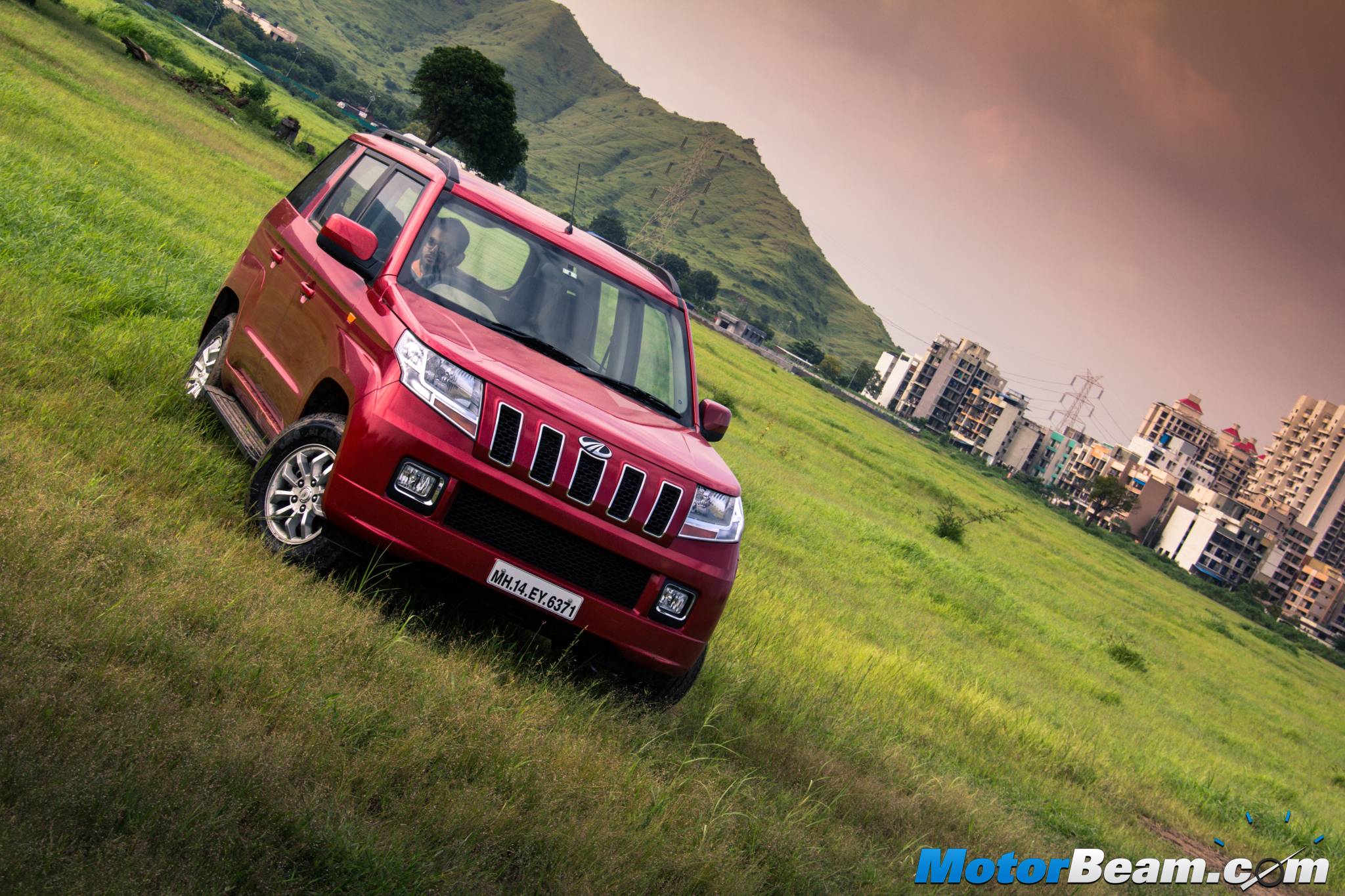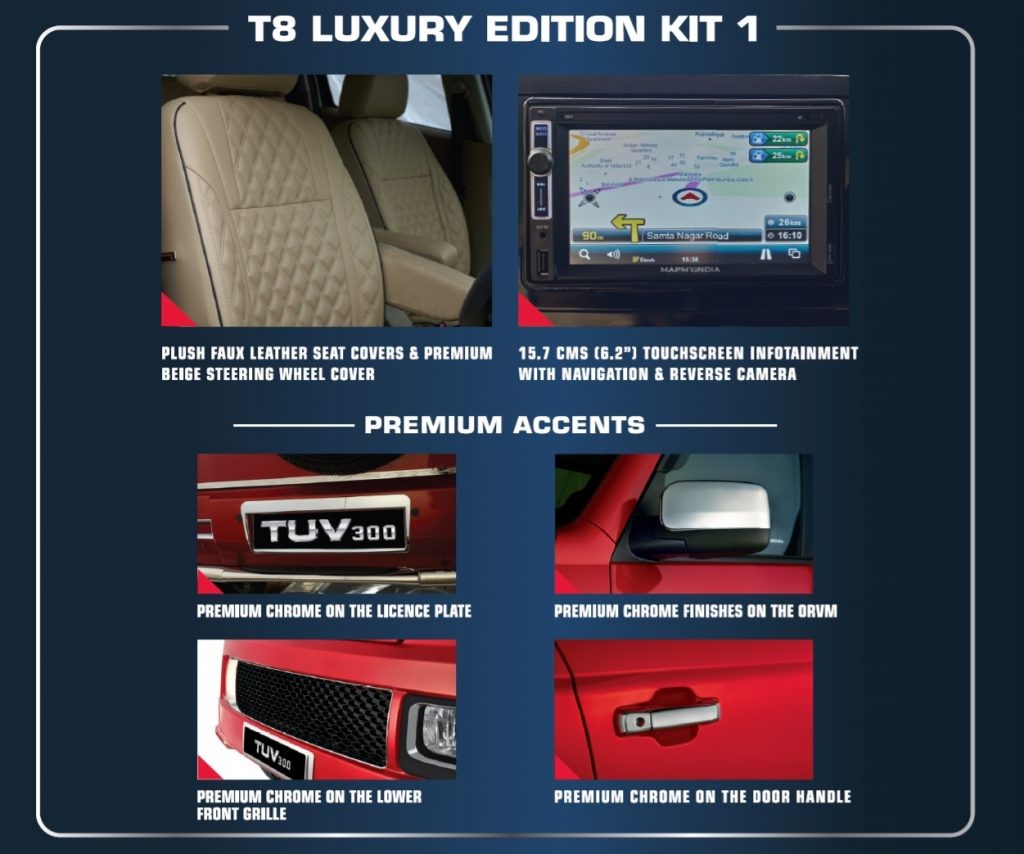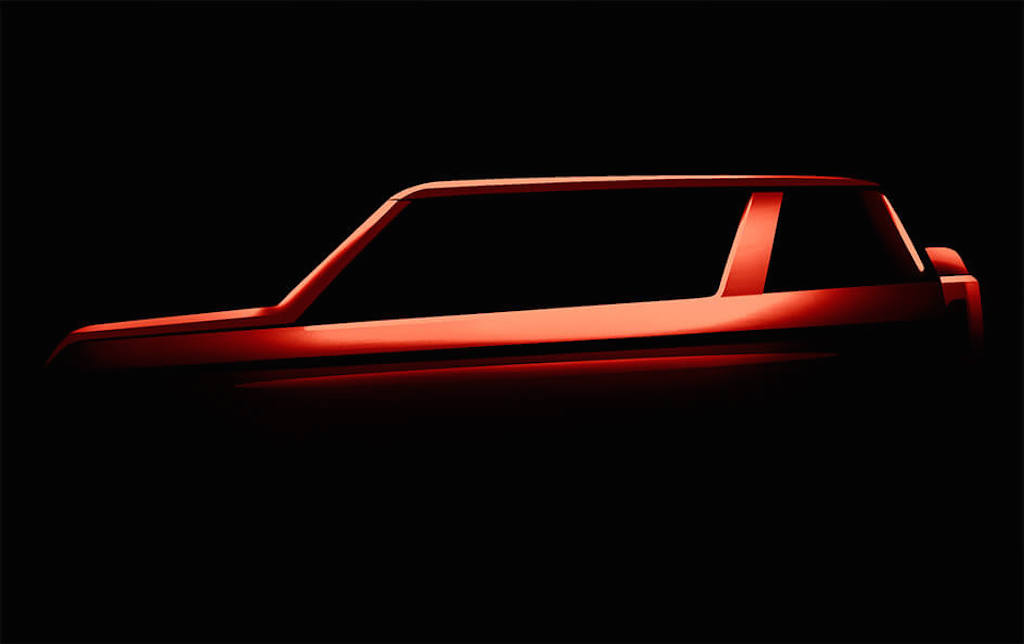
Mahindra TUV300 Review
Car Tested: 2015 Mahindra TUV300; Road Test No. 616
Price OTR Mumbai: Rs. 8.42 – 11.09 lakhs
The Mahindra TUV300 is as rugged as its name suggests with value being its strongest suit
Compact SUVs, they come in two sizes – S and XS, the latter getting the crucial excise duty advantage and yet we have very few options. Mahindra quite literally started the sub 4-metre compact SUV segment (the highly outdated Premier RiO aside) by taking a big saw and chopping off the backside of its Xylo MPV, OK, there certainly is more than what meets the eye but I digress. The MPV based Quanto faltered on many fronts and new entrants in the segment lead to sales dropping drastically. Time for a new SUV for the UV specialist then, only thing being, the TUV300 isn’t the successor to the Quanto but we at MotorBeam feel it fills those shoes till the updated model is launched. After driving it on the Mahindra test track, we quite liked the product but time for a detailed road test to judge the real character of this “Tough Utility Vehicle”.
Motor Quest: Mahindra was the first-mover in the sub 4-metre compact SUV space with the launch of the Quanto in 2012 but the vehicle failed to sell well. Now with the TUV300, the company is looking at making a mark in the compact SUV segment.
The TUV’s design is very boxy and the styling has taken heavy influence from Jeep
Exteriors – When the pictures of the Mahindra TUV300 first surfaced with camouflage (a time when the vehicle was only addressed by its codename U301), everyone thought it’s the new Bolero because of the boxy design. After Mahindra announced the name, the TUV300’s uncamouflaged pictures surfaced and we were definitely not impressed. In person though, the car does look better but there is just too much influence from global car makers like Land Rover but mostly from Jeep’s Wrangler. The TUV does flash Mahindra’s new design language and the perception from the common man seems positive with many asking about the vehicle.
The Mahindra TUV300 looks bigger than what its sub 4-metre length suggests
The TUV has been inspired from a battle tank, we wonder which one!
Mahindra has done a smart job with the dimensions of the TUV300 as it doesn’t look small in spite of tucking under the 4-metre length. The boxy design does give it that retro SUV feel and there are some macho elements like the big bumpers, high ground clearance, front grille with chrome inserts and the spare wheel mounted on the tail gate. Mahindra states that the design is inspired from a battle tank and while that might seem a bit too far fetched, the TUV300 does come across as a neutral looking car which appeals to a certain number of SUV lovers.
The dashboard design hasn’t been overdone like on other Mahindra vehicles
Interiors – While on the outside, you certainly don’t feel that the Mahindra TUV300 is a sub 4-metre vehicle, the same can be said about the inside too. This is because the cabin is big, there is plenty of room all around and the design is also very pleasant. Starting with the dashboard, there is no denying this is the best we have seen in any Mahindra car till date, XUV500 included. The design theme is more balanced, nothing seems over the top and the colours blend in well, the styling of the interiors has finally matured at Mahindra.
The placement of power window switches in the centre is very inconvenient to use
The TUV300 has a big cabin and there is plenty of space on the inside
The dashboard gets the dual-tone black and beige theme and the seats and other parts of the cabin are finished in beige for that airy feel. The 4-spoke steering wheel feels nice to hold and is chunky enough but audio controls are only on the left side and there is nothing on the right. There are silver inserts around the AC vents and the centre console gets piano black finishing, so does the surrounds of the gear lever. There are some storage spaces around the handbrake but the positioning of the power window controls there seems out of place and quite inconvenient to use. The instrument cluster is easy to read and also has a gear position indicator, the twin pods get a chrome surround on them. The front seats get an arm rest each while the rear misses out on them but the rear bench will easily accommodate three due to the wide cabin and almost flat floor.
Rear seat can accommodate three people in comfort, good space and width in here
The audio system gives out decent output, nothing great but better than average and there are charging ports for both front and rear seats. The glovebox is quite small, the door pockets will easily take a 1-litre bottle and on top of the centre console, there is space to keep your phone. Both the front seat back get magazine holders. The car has voice assist which will welcome you when you enter the car and warn you when you don’t wear your seat belt or when one of the doors is open or when you drive with the handbrake on. The commands take first preference and the reverse parking sensors buzzer and a phone call will be muted for the voice assist system to take over. The info function on the audio system also has distance to empty, mileage and a service due reminder. Equipment levels are good with useful things like static bending lights which are cornering lights (the headlight illumination is strong!) but a climate control AC should have been offered on the top trim. Other features include follow-me-home headlamps, reverse parking sensors, audio system with Bluetooth and BlueSense mobile app (doesn’t work flawlessly).
Last row of seats best used by no one, omission of seat belts here shocking
Space inside the cabin is the TUV’s USP as the second row is very accommodating with plenty of leg, knee and headroom, although under-thigh support is a bit lacking. Quality of the interior is good but not in the same league as other compact SUVs. Build quality as expected from a ‘Tough Utility Vehicle’ is well.. tough. The AC works well to chill the cabin but there are no vents for the rear, the AC gets an Eco mode too. The last row gets side facing jump seats to make the TUV300 a 7-seater, these eat into the boot space but the seats can be folded for extra space. The small jump seats are best suited for children but since there are no seat-belts here, it’s best not used by anyone. The tail-gate door does have a cup holder and a big pocket to keep odds and ends. The key of the vehicle has a button to turn on the hazard lights, neat.
The new 1.5L mHawk80 engine excels when it comes to in-city drivability
Performance – The Mahindra TUV300 is powered by a new engine, it’s a heavily re-worked unit which powers the Quanto. The 1.5-litre powerplant has been given a slew of updates and has also received the mHawk80 badging, producing 84 BHP of power and 230 Nm of torque. The motor uses a twin-stage turbo and compared to the Quanto, power is down by 15 PS and torque is down by 10 Nm but is available earlier on in the TUV. In spite of the lower numbers (more so when considering the weight of the three double oh), performance is quite good, specially in the city as turbo lag is very well contained. Around 187 Nm of torque is available right from 1100 RPM which means driving in high gears at low speeds doesn’t make the TUV uneasy. Drivability is certainly the forte of the TUV300 and it effortlessly keeps up pace in the city. In-gear acceleration is good too, 40-100 km/hr in third taking 9.03 seconds, 40-100 km/hr in fourth taking 15.70 seconds while 60-120 km/hr in fifth takes 26.10 seconds.
The TUV lacks punch on the highway and power trails off quickly past 3000 RPM
Floor the TUV300 hard and there is some jerk from the 3-cylinder mill
The Mahindra TUV300 does start off with a rumble but settles into a refined idle, it’s only when you stretch the mill past the mid-range does the diesel drone make itself felt and the vibrations start to creep in plenty at higher revs. The motor itself doesn’t like to rev and is quite slow in gaining RPM, the mid-range starts to fade quickly and post 3500 RPM, there isn’t much left in this oil burner. Top-end is almost non existent and going all the way to its 4600 RPM redline (4800 RPM in first and second) is a futile exercise at best. Doing the ton in top gear results in 2400 RPM on the tacho and while the clutch isn’t on the heavier side, the gearbox is a bit notchy and doesn’t offer smooth shifts at all times. 100 km/hr comes up in fourth gear and the time taken is a whooping 17.30 seconds but it could be worse?
The gearshifts are a bit notchy; Eco mode dulls performance drastically
Yes, because the worst part is the Eco mode which boosts mileage at the cost of dulling performance drastically. With the Eco mode on, the Mahindra TUV300’s mHawk motor finds great difficulty in climbing past 3500 RPM and the increase in revs is slower than an ant, even when your foot is firmly planted on the accelerator pedal. It won’t rev past 4000 RPM either and the motor seems to have hit a wall. 0-100 km/hr takes 28.85 seconds with the Eco mode and unless you are too mileage conscious, this mode is best avoided as the loss in performance is too drastic. The car also gets a stop and start system which works well when you come to a halt on say a traffic signal. While ARAI certified mileage is 18.49 km/l, our test car managed to return 13 km/l. There is also an AMT variant (offers a jerky drive experience but doesn’t reduce fuel economy) which is a big USP as that makes the TUV300 the cheapest diesel automatic SUV in the country.
Handling isn’t the TUV300’s strength, there is considerable amount of body roll
Driving Dynamics – Mahindra has gone ahead with the same thinking that they did with the Quanto, the TUV300 is also underpinned by a body-on-frame platform, resulting in the vehicle weighing a hefty 300 kgs more than its closest rival, the Ford EcoSport. But unlike the Quanto which is based on the Genio platform, the TUV uses the same modular chassis that underpins the new Scorpio, thus both the 300 and Scorpio share the same wheelbase length too! A ladder frame has its negatives and with the tall height, the TUV is far from being a confident drive as there is considerable body roll. Compared to the Quanto, the TUV is definitely more balanced and doesn’t’ induce the tipping-over feel of the Xylo based compact SUV. You do sit fairly high up which is good from the point of all-round view but can also induce the dizzy feeling in some people.
The TUV’s high profile rubber and suspension set-up give it an excellent ride quality
The ride quality on the TUV is supreme, it glides over tarmac, absorbing everything in sight
The steering does have some weight right from low speeds which might be a bit excess for city driving but as you gather pace, that weight does result in decent feel although feedback isn’t that great but remember, you won’t be pushing this car around corners either. The TUV channels power to the rear wheels and uses Ceat all-terrain rubber which isn’t the best for on-road driving. The high profile tyres might look a bit awkward on the TUV300 but they do help in giving the vehicle a very good ride quality as this Mahindra absorbs almost everything in its stride with utmost confidence. The only gripe is some bounciness felt on inconsistent tarmac, otherwise the car remains stable at speed. Braking performance is decent but the TUV300 takes 3.76 seconds to come to a standstill from 80 km/hr, the ABS working well to prevent a lock-up but the higher weight increases the stopping time. Pedal feel itself is a bit spongy and there is some nose dive under hard deceleration.
All variants get airbags, even though the lower trims get it as an option
Safety and After Sales Service – The TUV300 is offered with dual front airbags and ABS as optional on the T4 variant while the T6 variant gets ABS as standard. Airbags and ABS with EBD are standard offerings on the T8 variant. This is quite a good step taken by Mahindra since safety is quite a norm now and most customers have finally realised the importance of these features. In terms of service, well the automaker has a lot of service stations across the length and breadth of the country and there are service centres located in remote areas too. Hence, TUV300 buyers need not worry much when it comes to servicing their vehicles.
The Mahindra TUV300 doesn’t seem to be a vehicle for urban markets
Verdict – Mahindra has put in a lot of effort in making the TUV300 and it does show in certain areas. However, still opting for a ladder-frame chassis has resulted in the vehicle losing out in certain areas like performance, handling and mileage. But the body-on-frame layout has its advantage and that’s in terms of cost, the TUV300 undercuts its rivals by a significant amount. But that’s not the point because the way we at MotorBeam see it, the TUV appears like a more modern alternative to the Bolero and thus the three double oh will end up cannibalising its sales. The Mahindra TUV300 is a good attempt but will appeal largely to those in semi-urban or rural markets only.
While Mahindra has done a good job with the TUV300 for the price it is offered at, the vehicle seems firmly geared towards the rural audience and will end up eating into the sales of the Bolero. The attributes of tough, seat-belt less 6th and 7th passenger seats, and frugal but powerless motor in eco mode are something that won’t impress urban dwellers.
Mahindra has loaded the TUV300 with quite a lot of features for a VFM appeal
What’s Cool
* Looks tough and has the traditional SUV design cues
* Interior space is impressive, the cabin is wide
* Voice assist system works well, more so because the handbrake doesn’t disengage completely always
* Low-end performance is excellent, pulls cleanly from idle without much lag
* Ride quality is commendable, absorbs bumps with ease
* Interior feel and appearance is by-far the best in any Mahindra vehicle yet
What’s Not So Cool
* Body-on-frame platform makes it heavy resulting in lower performance and mileage
* Dynamics are nothing to talk about
* Vibrations kick in plenty at higher revs
* There is no top-end performance or outright performance from the 3-pot mill
* Name sake 7-seater, last row shockingly lacks seat-belts
Alternatives: Mahindra Bolero, Mahindra Quanto, Ford EcoSport, Renault Duster
Outside the Mahindra stable, the TUV300’s closest rival is the Ford EcoSport
Mahindra TUV300 Specifications
* Engine: 1493cc, 3-cylinder, 2-stage turbocharger, BS4, mHawk80 diesel
* Power: 84 BHP @ 3750 RPM (Manual); 81 BHP @ 3750 RPM (AMT)
* Torque: 230 Nm @ 1500-2250 RPM
* Transmission: 5-speed manual, 5-speed AMT
* 0-100 km/hr: 17.30 seconds, 28.85 seconds (Eco Mode)
* Top Speed: 150 km/hr
* Fuel Consumption: 12-13 km/l (City); 15-17 km/l (Highway)
* Fuel Type: Diesel
* Suspension: Double Wishbone (Front), Rigid Axle Multi-Link (Rear)
* Tyres: 215/75/15
* Brakes: Ventilated Disc (Front), Drum (Rear), ABS
* Safety: Dual Airbags, ABS, EBD, CBC
Mahindra TUV300 Dimensions
* Overall length x width x height: 3995 mm X 1835 mm X 1839 mm
* Wheelbase: 2680 mm
* Turning Radius: 5.35 metres
* Ground clearance: 190 mm
* Boot Volume: 384 litres, 720-litres (with seats folded)
* Fuel Tank Capacity: 60 litres
* Kerb Weight: 1580 kgs
The TUV300 makes for a great alternative to the high-selling Bolero
Testers’ Note:
Catch All The Latest Videos, Subscribe To
Picture Editing – Sri Manikanta Achanta
Further Reading –
Mahindra TUV300 mHawk100 Review
Mahindra TUV300 vs Ford EcoSport
Mahindra TUV300 vs Ford EcoSport – Video



